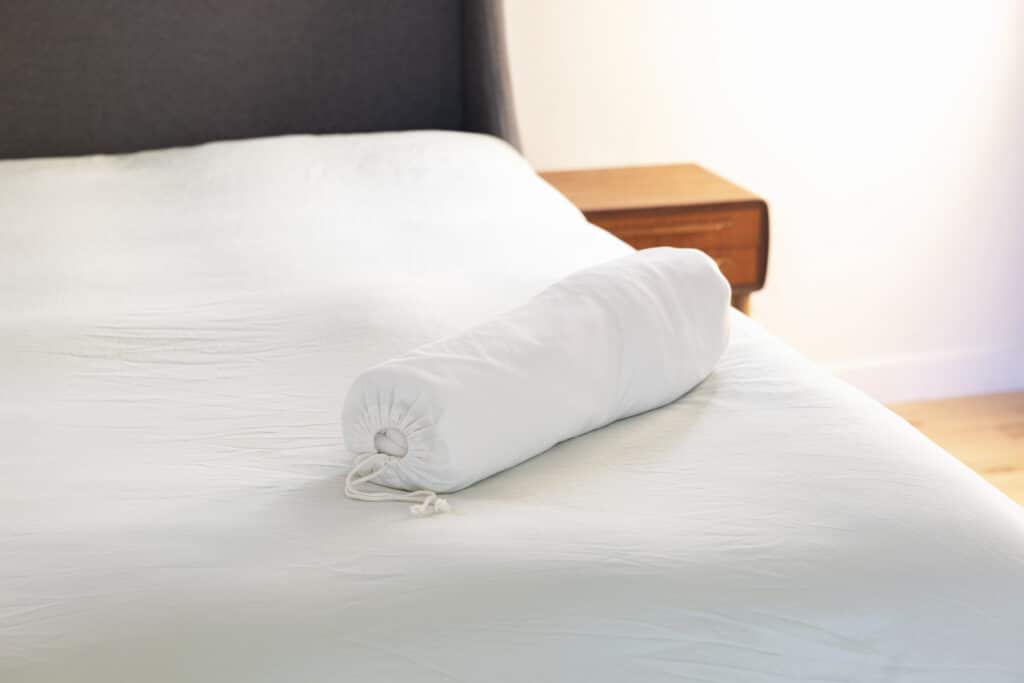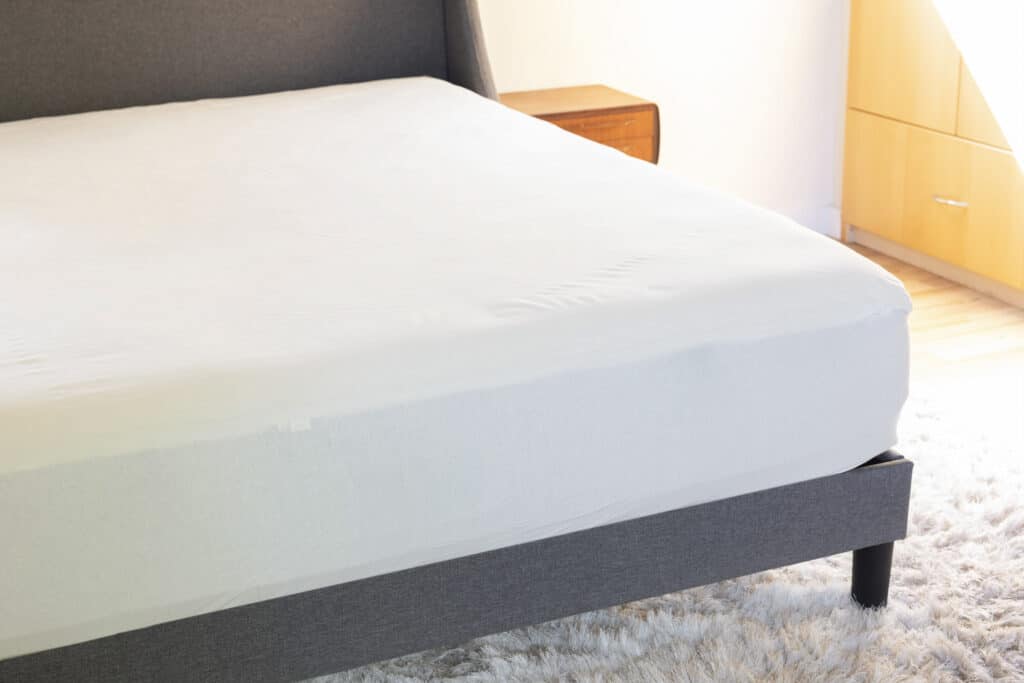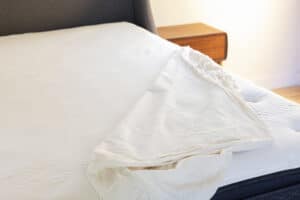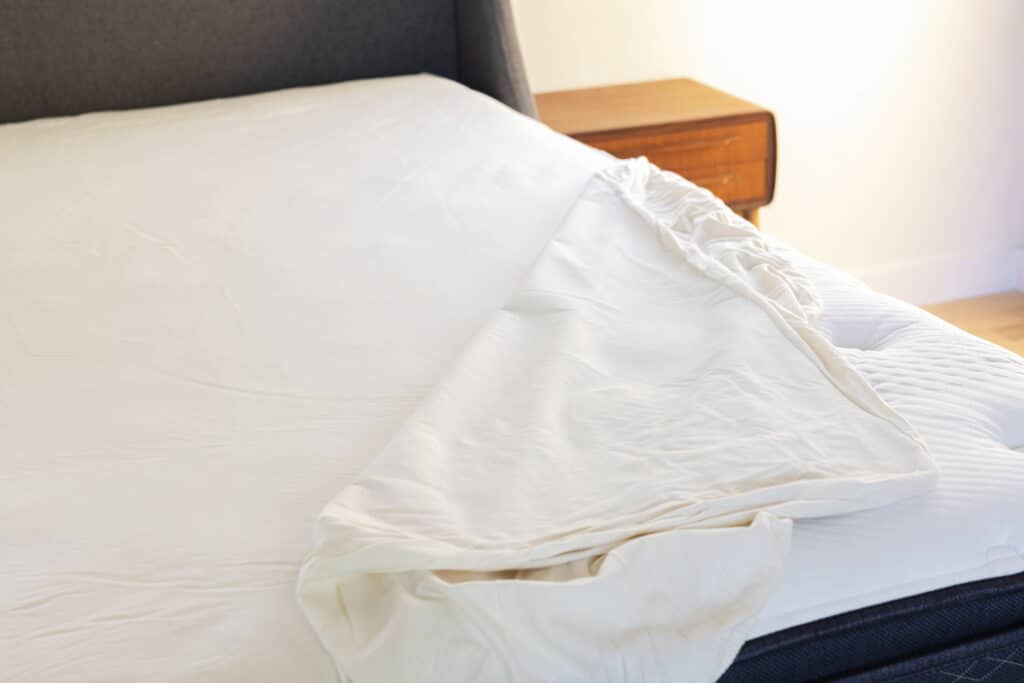It matters which materials make up a mattress pad or protector. After all, different materials do the job better than others. Most mattress protectors contain unnecessary synthetic materials and hazardous chemicals, though. Here’s what to avoid in a mattress protector or pad.

Table of Contents
Mattress pads and protectors are meant to improve your comfort and safeguard your sleep-space. Unfortunately, most of these types of products are made of synthetic materials using hazardous chemicals. These can sabotage sleep and aren’t good for your health, your family, or the planet.
It’s often difficult, though, to figure out exactly what’s in a mattress protector or pad. Many product descriptions don’t accurately detail every material used, nor the processes involved in making the final product. This is particularly the case for waterproof or water resistant protectors or pads, where it’s often unclear what, if anything, confers those properties.
Here’s what to watch out for in mattress pads and protectors.

Chemicals of concern – what to watch out for in mattress protectors
Chemicals of concern in mattress pads and protectors include:
- Formaldehyde
- Adhesives (unless these are natural latex or similarly non-toxic)
- Hazardous antimicrobial or pesticide treatments
- Chemical stain repellants and waterproof coatings containing poly- or perfluorinated compounds (PFCs)
- Chemical flame retardants.
We recommend avoiding all of the above when choosing a mattress pad or protector. These chemicals are harmful to people and planet and totally unnecessary for protecting your mattress.
As for the materials in a pad or mattress protectors, watch out for:
- Spandex and polyester (often in the skirt, so check all materials carefully)
- Synthetic rubber (SBR, or styrene butadiene rubber)
- PVCs
- Vinyl
- “Laminates” – unspecified.
The synthetic materials above are also unnecessary and can easily be replaced by less harmful and less toxic alternatives.
That said, some ‘laminates’ are better than others. If a company doesn’t specify what the laminate comprises, ask! It could be SBR, vinyl, or something else you’ll want to avoid, or it could be a laminate comprising a thin layer of waterproof membrane between two layers of organic cotton. Details matter!
Now to the tough question….

Essential Mattress Protector
100% GOTS-certified cotton mattress protector. The Essential Mattress Protector has an earthy, natural feel. The fitted, lightweight pad is waterproof, machine-washable, and dependable in protecting your mattress from life’s little accidents.
Effective, natural, and non-toxic
The reality is that we’re not where we want to be when it comes to materials science and waterproofing. We’re close, and some manufacturers are trying harder than others. For now, though, it’s nigh on impossible to find a mattress protector that offers effective protection without some synthetic material as a waterproof membrane.
What are your best options, then, for a safe, non-toxic, mostly natural mattress protector? We recommend a very thin layer of breathable, Oeko-Tex certified:
- Polyurethane
- Thermoplastic polyurethane (TPU).
If a mattress protector has GOTS certification and contains one of the two materials above, this is a good sign that the waterproof membrane is safe and very thin and breathable. The manufacturer cannot, under GOTS certification rules, use any chemicals or materials in amounts that are unsafe.
Polyurethane and TPU in mattress protectors and pads
Many of our recommendations for fully waterproof mattress protectors and pads use a very thin layer of inert polyurethane as a waterproof membrane. This is usually sandwiched between layers of natural, breathable, material such as organic cotton.
We also recommend products that use a thin layer of TPU, which is a kind of polyurethane that is typically recyclable and biodegradable and made with less harmful chemicals and no phthalates. This is the laminate we used when making our GOTS certified mattress protector for the LeafScore store.
Wherever possible, look for products that carry GOTS certification or similar. This means that the waterproof membrane comprises less than 5% of the product and that the entire product does not contain other chemicals of concern, such as formaldehyde-based adhesives and so forth.

Polyester and spandex
I recommend avoiding mattress pads and protectors that feature spandex or polyester. These are more common in protectors and pads that stretch over a mattress like a fitted sheet or as a full encasement.
Why avoid polyester and spandex? Because these materials:
- Can irritate skin
- Make you sweat
- Release microplastics when washed
- Contain BPA and other chemicals
- Don’t biodegrade and are hard to recycle.
None of this makes for a good night’s sleep.
In some cases, you’ll see a tiny amount of spandex or polyester in corner ties or elastics, or as product labels. This isn’t as bad as having most of the pad or protector made up with these synthetic materials. However, I love to see companies go the extra mile and use organic cotton tags and ties.
PVC, Vinyl, and Laminates
If you ever slept on a waterproof mattress protector when you were young, chances are it made a terrible noise and needed replacing every other week due to tearing and cracks. These mattress protectors were made with vinyl. Or, more specifically, polyvinyl chloride (PVC).
Vinyl waterproof mattress protectors are less common now than in years past. But when PVC is used, it often comes along with phthalates and other plasticizers that make the PVC more flexible and less likely to crack. While this is good for durability, it’s not great for your health. Phthalates are endocrine disruptors, meaning they upset hormone balance.
Given that most waterproof mattress covers are used on children’s beds and for convalescents, it’s definitely best to avoid PVC and any chemicals harmful to human health and development.
Watch out, too, for products made with undisclosed “laminates”. This could mean PVC, polyurethane, SBR, or something else entirely. If it’s not clear, ask the company. If you’re lucky, it might mean that the waterproof membrane is made of a bioplastic derived from corn oil or such, rather than a toxic petroleum-based material.
SBR
Similar to PVC, synthetic rubber, AKA styrene butadiene rubber (SBR) is definitely one to avoid in mattress pads, protectors, and all other home textiles.
SBR is a petroleum product, not natural latex rubber. It isn’t as durable as natural latex, tears easily, and off-gases terribly. And those volatile organic compounds (VOCs) coming from SBR include styrene and butadiene, which have a slew of negative effects on health (read more about those here).
Recycled plastics
While uncommon, some mattress protectors are made using recycled synthetic materials. In this case, it’s usually recycled polyester or polyethylene.
On the face of it, this seems like a good thing, given the ubiquity of plastic in the world’s oceans, waterways, and landfills. However, research suggests that these recycled plastics can expose us to a wide range of chemicals of concern, including flame retardants and endocrine disruptors that are now banned for us in new products.
Read more about these issues here.
Processing and finishing
In addition to the main materials in mattress pads and protectors, it’s worth paying attention to the processing and finishing chemicals that go into making the product. This includes things like:
- Chlorine bleach – which can give rise to carcinogenic dioxins
- Formaldehyde – to sterilize raw materials and as an anti-wrinkle treatment
- Flame retardants – especially in thicker mattress pads
- Synthetic adhesives – used in some layered products and liable to off-gas and break down over time
- Stain repellants and waterproof coatings – sometimes made with ‘forever chemicals’, AKA PFCs that harm human health and the environment.
In short, avoid all of the above. Look for products made with certified organic, natural materials and free from chemicals of concern. Mattress pad and protector certifications can help save you some of the legwork here, as can our lists of recommended products included as part of this Guide to Non-Toxic Bedding.

Essential Mattress Protector
100% GOTS-certified cotton mattress protector. The Essential Mattress Protector has an earthy, natural feel. The fitted, lightweight pad is waterproof, machine-washable, and dependable in protecting your mattress from life’s little accidents.
Final thoughts
Now you know what to look for in product descriptions, it’s easy to quickly dismiss products that aren’t sustainable and supportive of good sleep.
Where product listings are vague, check with the company that their protectors or pads are free of the materials and chemicals detailed above. If the response is also vague or non-committal, move on. There are plenty of fantastic, eco-friendly, non-toxic mattress protectors and pads available, including from companies that care about their customers and the planet.
See our top choices for mattress pads and our recommendations for more sustainable, non-toxic mattress protectors here.